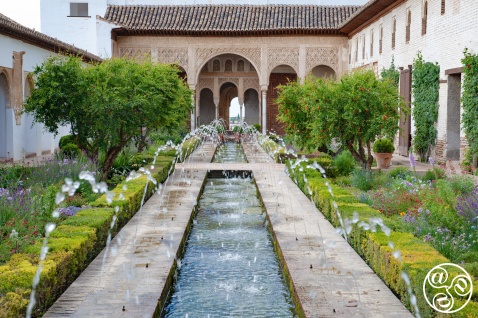Generalife gardens of the Alhambra
The word "Generalife" has been translated as "garden of paradise", "orchard" or "garden of feasts".
After the city was conquered, the Generalife was granted by the Catholic Monarchs to the Granada Venegas family. The promenade leads to the "Patio de la Acequia" which is the most celebrated spot and the heart and soul of the palace grounds. On the western side there is a gallery of 18 arches. The northern portico is called the Mirador and has five arches in front, slender and stylised and three behind made of marble with stalactite capitals. Through the north portico is the "Patio de los Cipreses", with a pool in the centre.
The distribution of the small ponds is charming with their frames of oleander and myrtle. A stone step leads to the Upper Gardens which were once olive groves and today boast a handsome esplanade and modern gardens. Here is the unusual stairway with its cascading waterfalls which was described by Navagiero as early as the 16th century. The stairway leads to a modern, uninteresting edifice of several stories. At the far end is the large open air stage where the annual International Festival of Music and Dance is performed. The Generalife became an UNESCO World Heritage site in 1984.
More on Generalife Gardens
by Lawrence Bohme
This charming villa overlooking the Alhambra is often said to have been the summer palace of the Sultans, but in fact it was a hunting lodge and country retreat, where the rulers, accompanied by their wives, could escape the turmoil of the palace. The Moors, like today's Andalucians, did not combat the heat by seeking the open air, but rather by withdrawing into shady, secluded patios and rooms.
The Spanish aristocrats who became its owners after the Reconquest radically altered the appearance of the little palace in the 19th century, adding an upper floor to the buildings at either end of the courtyard, opening the arched windows in the wall overlooking the Alhambra and installing the long rows of fountains which splice together in the air before splashing into the central pond.
One has only to compare the Generalife's courtyard to the other patios of the Alhambra to realise what a departure it is from the Moorish ideal of a perfect garden, which was totally enclosed, with, at either end of the central pond, a single fountain dish creating a burble which was just audible enough to break the silence.
In spite of the changes made by the Christians, the Generalife is the most charming corner of the Alhambra, thanks to its gardens and fast-flowing water. In fact, the name of the main courtyard is the Patio de la Acequia - Courtyard of the Water Channel - in reference to the water which coursed through the villa before supplying the Alhambra below.
In Moorish times, the long wall facing the Alhambra was unbroken by windows except for the central balcony or belvedere, which allowed the Sultan to look over his palace and enjoy the evening breeze.
The Christians opened the pointed windows in the wall, several of which are painted with the motto of the Catholic Monarchs, TATO MOTA, which, according to popular wisdom, is an abbreviation for "Tanto Monta el Rey como la Reina", loosely translatable as "The King sits as firmly in the saddle as the Queen". Isabella, as Monarch of Castile, was politically stronger than her husband Ferdinand, King of Aragon, and the motto reminded her that the coalition - consecrated by their marriage - gave equal rights to both.
The upper floor of the pavilion at the far end of the patio was added in the 19th century by the heirs of the Count of Tendilla, but the lacey openwork of the arcades built by the Moors is miraculously intact.
One of the favourite legends of the Alhambra tells of a rendez-vous between the Sultana and a knight of the rival Abencerraje family, in the shade of this great cypress, which is now called the Ciprés de la Sultana. The tree is so old that it has to be held up with a metal brace. After they were discovered, the legend has it, all the men of the Abencerraje family were massacred, on the orders of the jealous Sultan.
The escalera del agua, or "water staircase" is genuinely Moorish. The ideal of the "desert people" was to have water flowing everywhere, even, it seems, along the bannisters of their staircases!
Next page > Hill of the Martyrs
Buy your copy of - Granada, City of My Dreams
 Granada, City of My Dreams: An Historical and Artistic Guide to Granada and its Moorish Palace the Alhambra
Granada, City of My Dreams: An Historical and Artistic Guide to Granada and its Moorish Palace the Alhambra
This itinerary was written for Andaluca.com by Lawrence Boheme author of “Granada, City of My Dreams”. For, what fascinates us about this universal city is not only its monuments but its marvellous story, “the encounter between Moor and Christian, gypsy and Jew, medieval and Renaissance, glistening snow and Mediterranean sun. Lawrence Bohme, poet, illustrator and curious traveller, has filled these pages with luminous descriptions and drawings, the culmination of forty years of wanderings through the palaces and labyrinths. Amazon.co.uk or Amazon.es
Hotels within the Alhambra's grounds
Hotels within the Alhambra's grounds
Hotels next to the Alhambra
Hotels next to the Alhambra
Location
Part of the Alhambra complex




